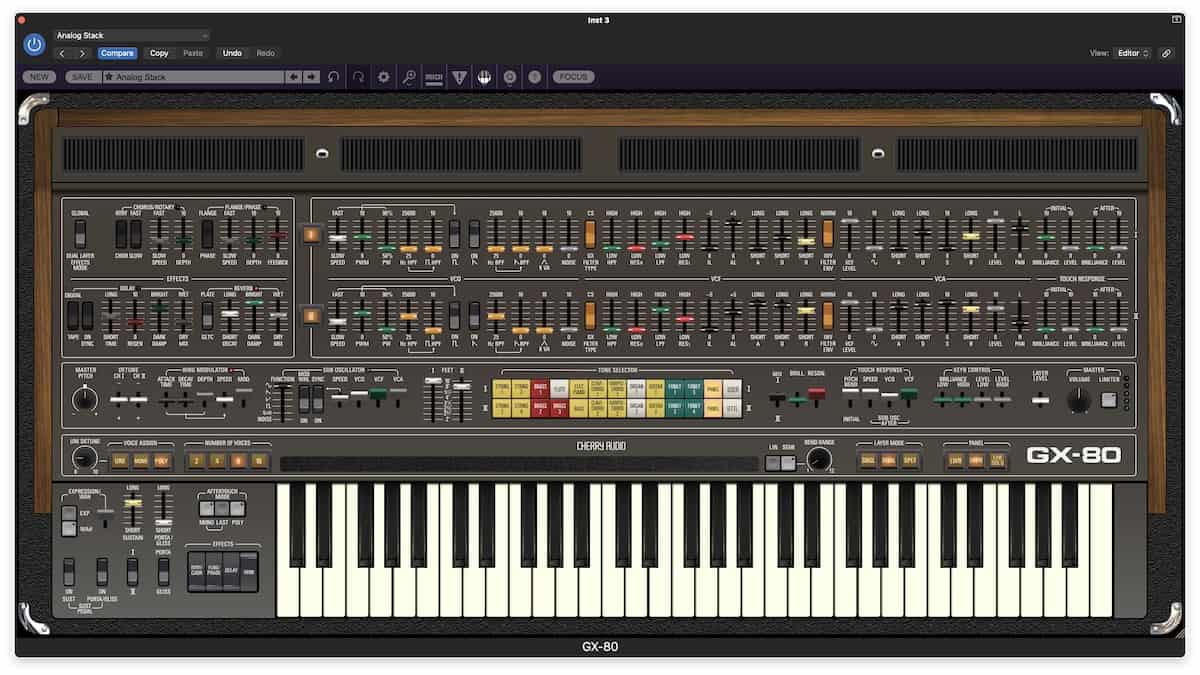In This Issue
Cherry Audio Announces GX-80 – and Here’s the Synth and Software Review

Marty Cutler gets handsy with Cherry Audio’s amazing new flagship softsynth, a combination of two classic dream machines
It cost $60,000, it was impossible to program without a dedicated programmer, it was huge, heavy, ungainly, and less than 100 were manufactured.
Stevie Wonder allegedly bought two of Yamaha GX-1 synths, called it “the dream machine,” and used it all over his Songs in the Key of Life album. Keith Emerson had one, John Paul Jones had one, and the later CS-80 version of the instrument pervaded Vangelis’ soundtrack for “Bladerunner.”
Why were these two instruments so readily adopted by these elite (not to say wealthy) musicians?
Memory Lane. The GX-1 was the result of Yamaha’s ventures into new technology – a large and expensive flagship instrument. Released in 1974, the GX-1 represented the absolute cutting edge of organ and analog synthesizer technology. Roughly 20 units were manufactured.
The GX-1 was a preset instrument without an external hardware programmer. User patches were saved to separate cartridges. Storage procedures that were somewhat byzantine, consisting of the programmer, a setting box that operated by adjusting 26 tiny screws, and finally the cartridge itself.
GX-80 demo by Nick Batzdorf
Yet for all its unwieldiness, the GX-1 was the first truly polyphonic synthesizer, offering up to 16-note polyphony. It had a ribbon slider for pitch, and polyphonic key pressure, among other advanced features. There was nothing else like it at the time, feature- or sound-wise.
Yamaha released the CS-80 a couple of years after the debut of the GX-1. It shared much of the design of the GX-1, but with half the number of voices, or ranks, as Yamaha referred to a complete synthesizer signal path. A rank comprises an oscillator, high- and low-pass filters, a noise generator, a sine wave oscillator, discrete envelope generators for the filter and VCA, and a VCA.
There was an additional filter in the GX-1 that was omitted from the CS-80. The GX-1 ring modulator was capable of sounds ranging from subtle, animated tones to harsh, growling timbres.
The GX-80 softsynth. Cherry Audio’s GX-80, as you may have guessed, incorporates the GX-1’s architecture with that of the CS-80 – additional voice ranks and waveforms with variable resonators. GX- 80 also replicates the GX-1 filter to produce timbres beyond the scope of the CS-80.
The result is a synthesizer well beyond the sound-sculpting capabilities of either instrument, while retaining the sound of the original synths. Furthermore, the software version lets you build split and layered tones for added girth and timbral motion. If you find that the panel’s controls aren’t doing what you expect, it’s because the instrument swaps between Upper and Lower panel layers at the touch of a button.
The ribbon controller from the original is also in the GX-80, and it responds to the MIDI pitch wheel (or anything mapped to the pitch wheel outside the synth’s interface). Every other control can remember stored MIDI-learned mappings created with the usual watch-and-wiggle method.
GX-80 demo by Nick Batzdorf
As with the CS-80, Cherry Audio’s GX-80 harbors no hidden sub-basement menus to chase after; everything is laid out across the panels – which is a blessing, and could be a curse were it not for being able to enlarge its window and also zoom in with Cherry Audio’s Focus button. Otherwise the user interface, as with the CS-80’s, is almost impossibly busy, and a task for my aging vision to decipher.
I’ve said as much in other reviews: Cherry Audio’s Focus button is a godsend. You can zoom in on any section of GX-80’s parameters with in-your-face detail (Fig,4). You couldn’t get any closer without skinning your nose.
Oh by the way, the sound: For all that, I’ve said little about how GX-80 sounds, and this is why its forebears were embraced by the music elite. Its timbres could be rich, complex, and creamy, or gruff and aggressive. The filters are marvelous, and the ring modulator does a lot to provide variety.
GX-80 demo by Nick Batzdorf
Pads are fat and warm, brass is razor-sharp and bright, basses are powerful and full, and leads are expressive and tangy. How Cherry Audio emulates individual key pressure from Channel Aftertouch is voodoo to me, but it works, and goes a long way toward humanizing the lush strings and pads.
You can purchase this marvelous instrument for a micro-fraction of the hardware version’s cost, and what’s more, you don’t need to rent a trailer to schlep it around. I can’t believe you’re still sitting here reading this; you can download a free 30-day demo.
That is highly recommended.
Current price: $59



















